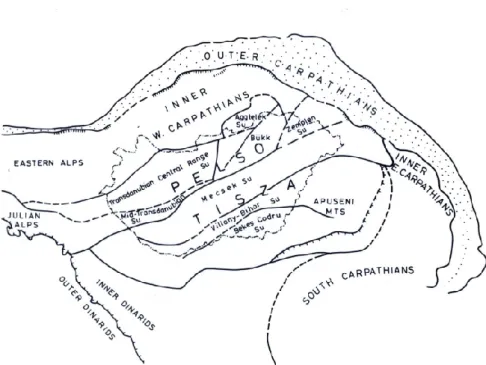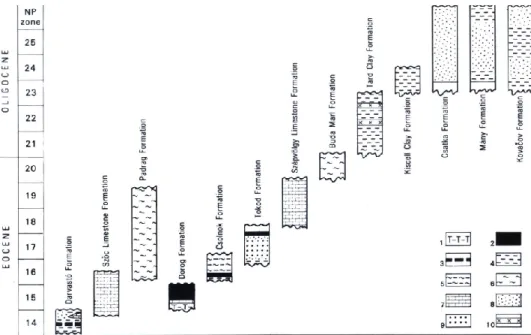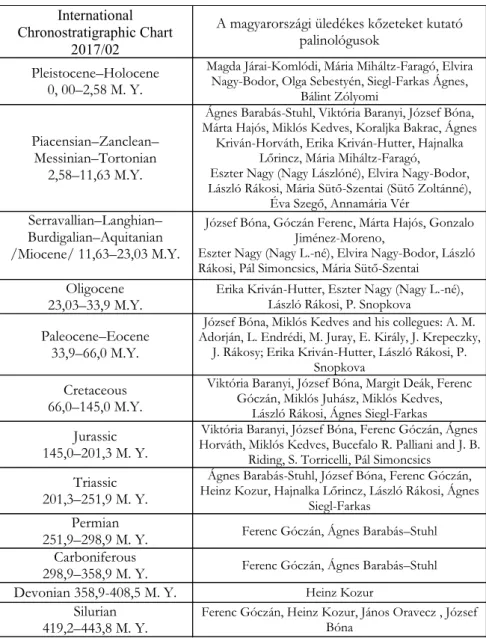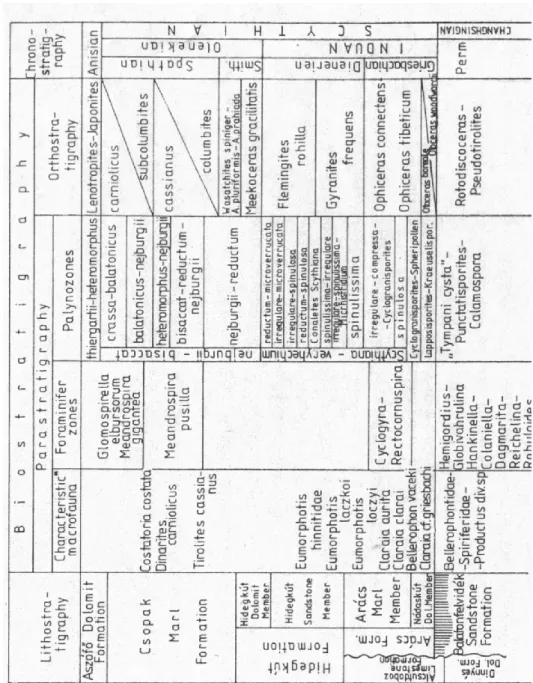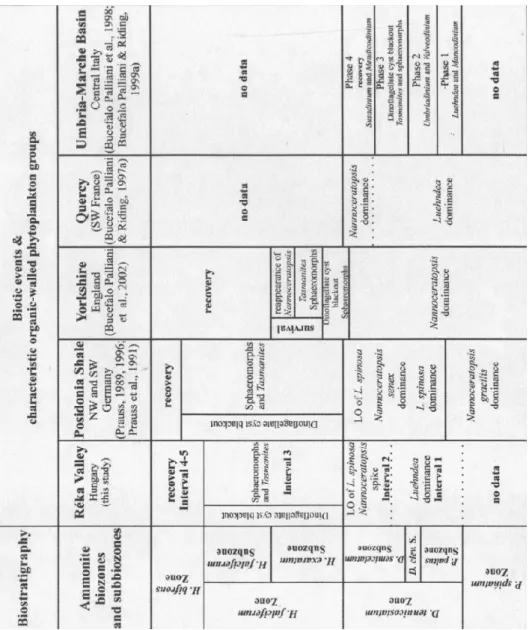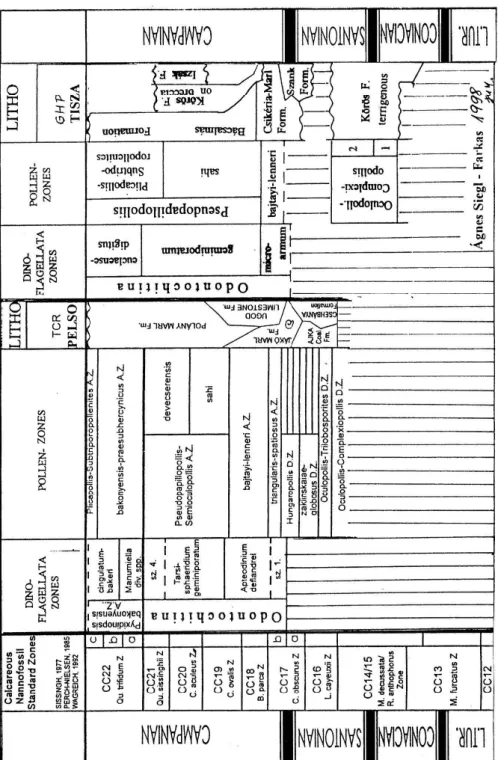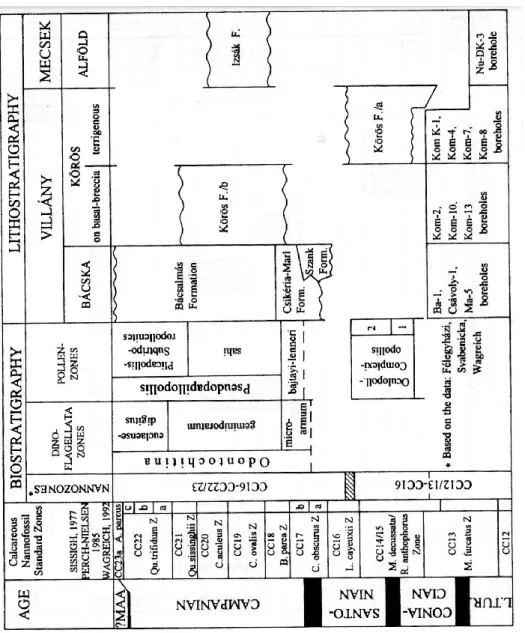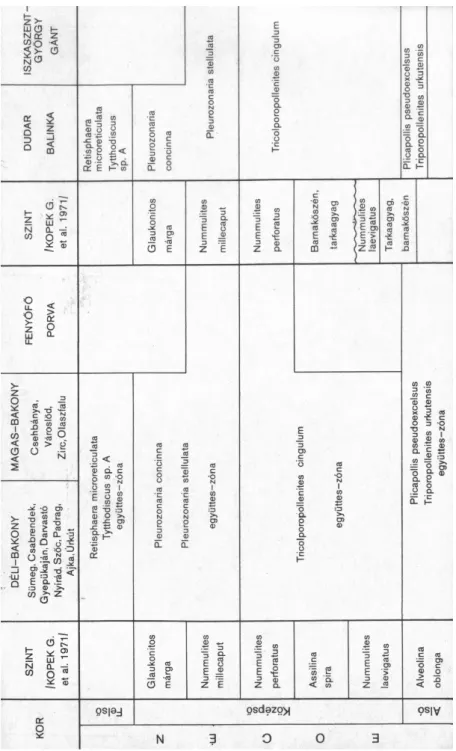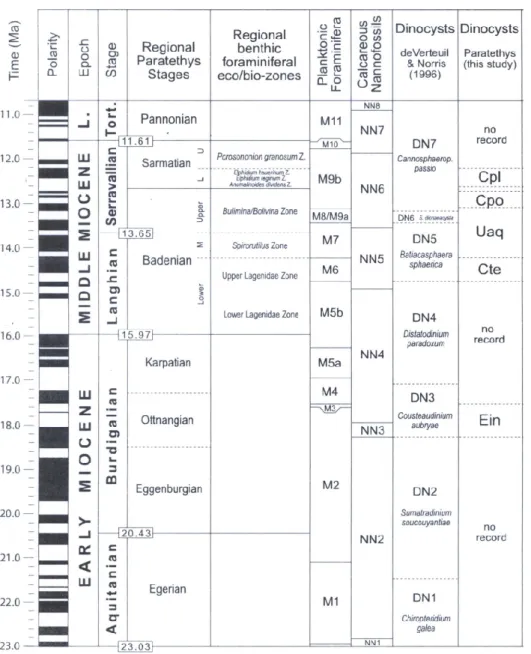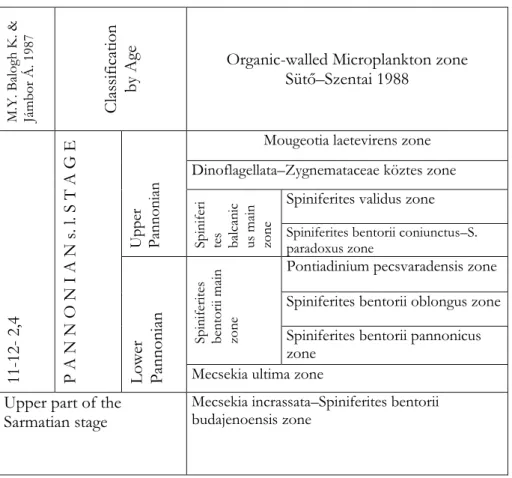Redigit Fazekas Imre
Pannon Intézet | Pannon Institute Pécs, Hungary
2018
e-Acta Naturalia Pannonica 18 | 2018
Sütőné Szentai Mária
Taxon-list of Silurian to Holocene organic-walled microplankton from Hungary
(1957–2017)
Szervesvázú microplankton fajok listája Magyarországról,
a szilurtól a holocénig
(1957–2017)
e-Acta Naturalia Pannonica 18: 1–203. | 01.06.2018
A folyóirat évente 1–3 kötetben zoológiai, botanikai, állatföldrajzi, természetvédelmi és ökológiai tanulmányokat közöl. Ezenkívül helyet biztosít geológiai, paleontológiai és arc- heológiai írásoknak, rövid közleményeknek, híreknek, könyvismertetőknek. Az archivált publikációk az Országos Széchenyi Könyvtár Elektronikus Periodika Adatbázis és Archí- vumban (EPA) érhetők el: http://epa.oszk.hu/e‐Acta_Naturalia_Pannonica
A nyomtatott kötetek a szerkesztő címén rendelhetők meg.
Acta is an Open Access journal. The serial is devoted to the study of Hungarian natural sciences and is instrumental in defining the key issues contributing to the science and practice of conserving biological diversity. The journal covers all aspects of systematic and conservation biology. E-Acta Naturalia Pannonica may be obtained from the Editor on a basis of exchange or via purchase.
Archives: http://epa.oszk.hu/e-Acta_Naturalia_Pannonica
Szerkesztő | Editor FAZEKAS IMRE
E‐mail: fazekas@microlepidoptera.hu | fazekas.hu@gmail.com
Lektorok |Redership Magyar Imre, Sóron András
Szerkesztőség | Editorial Board
Ábrahám Levente (Kaposvár), Bálint Zsolt (Budapest), Buschmann Ferenc (Jászberény), Nowinszky László (Szombathely), Puskás János (Szombathely), Szeőke Kálmán (Székes- fehérvár), Tóth Sándor (Zirc)
Kiadó|Publisher: Pannon Intézet |Pannon Institute |Pécs, Hungary Kiadványterv, tördelés, tipográfia |Design, lay-out, typography: Fazekas Imre Nyomtatás |Print: ROTARI Nyomdaipari Kft., Komló
http://www.actapannonica.gportal.hu
http://epa.oszk.hu/e‐Acta_Naturalia_Pannonica Megjelent |Published: 2018.06.01. | 01.06.2018
Minden jog fenntartva | All rights reserved
© Pannon Intézet | Pannon Institute |Hungary, 2018 HU ISSN 2061–3911 | DOI: 10.24369/eANP.2018.18.1
Contents – Tartalom
Introduction ……….. 8
Materials and methods ……… 10
Taxon-list of fossil organic-walled microplankton Organic-walled ………... 11
Microplankton/Phytoplankton zonations from Hungary ……….. 151
Acknowledgements ………... 154
Összefoglalás Szervesvázú microplankton fajok listája Magyarországról, a szilurtól a holocénig (1957–2017) ……..……… 157
Bevezetés ……….. 156
Anyag és módszer ………. 161
References – Irodalom ……….. 161
My way of life – Életutam ……… 183 INDEX
Dinoflagellata
Achilleodinium Eaton 1976 … 11 Achomosphaera Evitt 1963 … 11
Adnatosphaeridium Will. & Downie 1966c … 13 Alisogymnium Lentin & Vozzh. 1990 … 13 Alterbidinium Lentin & Williams 1985 … 14 Amphidiadema Cookson & Eisenack 1960a … 14 Amphidinium Claparéde & Lachmann 1859 … 15 Amphigymnium Lentin & Vozzh. 1990 … 15 Amphorosphaeridium Davey 1969c … 15 Apectodinium (Costa & Downie 1976) Lentin &
Williams 1977b … 15
Apteodinium Eisenack 1958a … 16 Araneosphaera Eaton 1976 … 17 Areoligera Lejeune-Carpentier 1938a … 17 Ascodinium Cookson & Eisenack 1960a … 17 Barssidinium Lentin & al. 1994 … 18 Batiacasphaera Drugg 1970b … 18 Biconidinium Islam 1983c … 19 Brigantedinium Reid 1977 … 19
Callaiosphaeridium Davey & Will. 1966b … 20 Canningia Cookson & Eisenack 1960b … 20 Canninginopsis Cookson & Eis. 1962b … 20 Cannosphaeropsis O. Wetzel 1933b … 21 Carpatella Grigorovich 1969a … 21 Cerebrocysta Bujak in Bujak & al. 1980 … 21 Cerodinium Vozzhennikova 1963 … 22 Charlesdowniea Lentin & Vozzh. 1989 … 22 Chatangiella Vozzhennikova 1967 … 23 Chiropteridium Gocht 1960 … 23
Chlamidophorella Cookson & Eis. 1958 … 24 Chytroeisphaeridia (Sarjeant 1962a) Downie &
Sarjeant 1965 … 24
Circulodinium Alberti1961 … 25 Cleistosphaeridium Davey & al. 1966… 26 Cordosphaeridium Eisenack 1963b … 26 Coronifera Cookson & Eisenack 1958 … 28 Corrudinium Stover & Evitt 1978 … 28
Cribroperidinium Neale & Sarjeant 1962 … 28 Ctenidodinium Deflandre 1939a … 30 Damassadinium Fensome & al. 1993b … 30 Dapcodinium Evitt 1961a … 30
Dapsilidinium Bujak & al. 1980 … 30 Deflandrea Eisenack 1938b … 31 Dinogymnium Evitt & al. 1967 … 33 Diphyes Cookson 1965a … 35
Disphaeria Cookson & Eisenack 1960a … 35 Distatodinium Eaton 1976 … 35
Downiesphaeridium Islam 1993 … 36 Dracodinium Gocht 1955 … 37 Emmetrocysta Stover 1975 … 37
Enneadocysta Stover & Williams 1995 … 37 Evansia Pocock 1972 … 38
Exocosphaeridium Davey & al. 1966… 38 Fibrocysta Stover & Evitt 1978 … 38 Florentinia Davey & Verdier 1973 … 38 Galeacysta Corradini & Biffi 1988 … 39 Geiselodinium Krutzsch 1962 … 39 Gillinia Cookson & Eisenack 1960a … 40 Ginginodinium Cookson & Eisenack 1960a … 40 Glaphyrocysta Stover & Evitt 1978 … 40 Gonyaulacysta Deflandre 1964 … 41 Gonyaulax Diesing 1866 … 42 Habibacysta Head & al. 1989b … 42
Heteraulacysta Drugg & Loeblich Jr. 1967 … 42 Heterosphaeridium Cookson & Eis. 1968 … 42 Homotryblium Davey & Williams 1966b … 43 Hystrichokolpoma Klumpp 1953… 44 Hystrichosphaera O. Wetzel 1933b … 45 Hystrichosphaeridium Deflandre 1937b … 45 Hystrichosphaeropsis Deflandre 1935 … 46 Hystrichostrogylon Agelopoulos 1964 … 47 Impagidinium Stover & Evitt 1978 … 47 Impletosphaeridium Morgenroth 1966a … 50 Isabelidinium Lentin & Williams 1977a … 51
3
Kalyptea Cookson & Eisenack 1960b … 52 Kenleyia Cookson & Eisenack 1965b … 52 Kleithriasphaeridium Davey 1974 … 52 Komewuia Cookson & Eisenack 1960b … 53 Labyrinthodinium Piasecki 1980 … 53 Leberidocysta Stover & Evitt 1978 … 53 Lejeunecysta Artzner & Dörhöfer 1978 … 54 Lentinia Buja kin Bujak & al. 1980 … 54 Leptodinium Klement 1960 … 55 Lingulodinium Wall 1967 … 55 Lithodinia Eisenack 1935 … 57 Litosphaeridium Deflandre 1933 … 57 Luehndea Morgenroth 1970 … 57
Maduradinium Cookson & Eisenack 1970a … 58 Mancodinium Morgenroth 1970 … 58
Manumiella Bujak & Davies 1983 … 58 Margosphaera Nagy 1965a … 59 Maturodinium Morgenroth 1970 … 59 Melitasphaeridium Harland & Hill 1979 … 60 Membranilarnacea Eisenack 1963a … 60 Membranophoridium Gerlach 1961 … 61 Mendicodinium Morgenroth 1970 … 61 Microdinium Cookson & Eisenack 1960a … 61 Millioudodinium Stover & Evitt 1978 … 61 Muderongia Cookson & Eisenack 1958 … 63 Nannoceratopsis Deflandre 1939a … 63 Nelsoniella Cookson & Eisenack 1960a … 64 Nematosphaeropsis Deflandre & Coo. 1955 … 64 Neuffenia Brenner & Dürr 1986 … 65
Occisucysta Gitmez 1970 … 66 Odontochitina Deflandre 1937b … 66 Odontochitinopsis Eisenack 1961 … 67 Oligosphaeridium Davey & Will. 1966b … 67 Operculodinium Wall 1967 … 68
Palaeocystodinium Alberti 1961 … 71 Palaeohystrichophora Deflandre 1935 … 72 Palaeoperidinium Deflandre 1934 … 72 Pareodinia Deflandre 1947d … 72 Pentadinium Gerlach 1961 … 72 Peridinium Ehrenberg 1830 … 73
Phthanoperidinium Drugg & Loeb. 1967 … 73 Polysphaeridium Davey & Williams 1966b … 74 Pontiadinium Stover & Evitt 1978 … 75 Pseudokomewuia He Chengquan 1980 … 77 Pterodinium Eisenack 1958a … 77 Pyxidiella Cookson & Eisenack 1958 … 78 Pyxidinopsis Habib 1976 … 78
Raetiaedinium Kirsch 1991 … 79 Raphidodinium Deflandre 1936b … 80 Reticulatosphaera Matsuoka 1983b … 80 Rhaetogonyaulax Sarjeant 1966b … 80 Rhombodinium Gocht 1955 … 80 Rhynchodiniopsis Deflandre 1935 … 81 Rigaudella Below 1982b … 81 Romanodinium Balteş 1971 … 81 Samlandia Eisenack 1954b … 82 Scrippsiella Balech 1959 … 82 Selenopemphix Benedek 1972 … 82 Senegalinium Jain & Millepied 1973 … 84
Seriliodinium Eaton 1996 … 84
Spinidinium Cookson & Eisenack 1962b … 84 Spiniferella Stover & Hardenbol 1994 … 85 Spiniferites Mantell 1850 … 85
Sumatradinium Lentin & Williams 1976 … 97 Surculosphaeridium Davey & al. 1966 … 97 Systematophora Klement 1960 … 98 Tanyosphaeridium Davey & Will. 1966b … 99 Tectatodinium Wall 1967 … 99
Tenua Davey 1978 … 100
Thalassiphora Eisenack & Gocht 1960 … 101 Tityrosphaeridium Sarjeant 1981 … 102 Trichodinium Eisenack & Gocht 1960 … 102 Trigonopyxidia Cookson & Eis. 1961a … 102 Trinovantedinium Reid 1977 … 102 Trithyrodinium Drugg 1967 … 103 Tuberculodinium Wall 1967 … 103 Turbiosphaera Archangelsky 1969a … 103 Umbriadinium Bucefalo Palli & R. 1997 … 104 Unipontidinium Wrenn 1988 … 104
Valvaeodinium Morgenroth 1970 … 104 Virgodinium Sütőné Szentai 2010 … 104 Wetzeliella Eisenack 1938b … 109
Wrevittia Helenes & Lucas-Clark 1997 … 110 Xenascus Cookson & Eisenack 1969 … 110 Xenikoon Cookson & Eisenack 1960a … 110 Chlorophyta
Botryococcus Kützing 1849 … 111 Closterium Brébisson … 112 Cooksonella Nagy 1965a … 112 Desmidiales Jost Casper 1982 … 113 Mougeotia Agardh 1824 … 113 Ovoidites (Potonie) Krutzsch 1959 … 114 Pediastrum Meyen 1829 … 115
Schizosporis Cookson & Dettmann 1959 … 116 Spirogyra Link 1820 … 117
Tetraedron Braun … 118 Tetraporina Naumova 1937 … 119 Zygnemataceae Kützing 1898 … 119 Zygnema type V. Geel & Hamm. 1978 … 119 Plankton A form Nagy 1969 … 119 Plankton B form Nagy 1969 … 120 Prasinophytae
Cymatiosphaera O. Wetzel 1933 … 120 Dictyotidium Jiabo 1978 … 122 Halosphaeropsis Mädler 1963 … 122 Mecsekia Hajós 1966 … 122
Microfoveolatodiscus Kedves 1965b … 122 Noremia Kedves 1962 … 124
Oraveczia Góczán 1997 … 124 Pachysphaera Ostenfeld 1899 … 125 Pleurozonaria O. Wetzel 1933 … 125
„Prasinophytes” Baranyi & al. 2016 … 128 Pterosperma Pouchet 1893 … 128 Pterospermella Eisenack 1972 … 128 Pterospermopsis W. Wetzel 1952 … 128 Sulcodiscus Góczán 1997 … 129
4
Tarsisphaeridium Riegel 1974 … 129 Tasmanites Newton 1875 … 129 Tytthodiscus Norem 1935 … 130 Vadászia Góczán 1997 … 130 Phaeophyceae … 131 Acritarcha Evitt 1963:
Annulodiscus Hajós 1966 … 131
Ascostomocystis Drugg & Loeb. 1967 … 131 Baltisphaeridium Eisenack 1958 … 131 Campenia Jiabo 1978 … 133
Cantharus ?Góczán 1962 … 133 Catillopsis Drugg 1970 … 133
Ceratocystidiopsis Deflandre 1937 … 133 Conates Góczán & al. 1988/1992 …133 Conaticystis Habib & Knapp 1982 … 133 Cyclopsiella Drugg & Loeblich 1967 … 134 Cystidiopsis Nagy 1965a … 134
Deflandridium Nagy 1969 … 134 Filisphaeridium Staplin & al. 1965 … 134 Fromea Cookson & Eisenack 1958 … 135 Gorgonisphaeridium Staplin & al. 1965 … 135 Hidasia Nagy 1965a … 135
Leiofusa Eisenack 1938 … 136 Leiosphaeridia Eisenack 1958 … 136 Metaleiofusa Schön. 1967 … 137 Micrhystridium Deflandre 1937 … 137 Nannobarbophora Head 2003 … 139 Odontomorpha Hajós 1966 … 140 Ollula Góczán 1962 … 140
Palaeostomocystis Deflandre 1937 … 140 Paralecaniella Cookson & Eisenack 1970 … 140 Polygonium Vavrdová 1966 … 141
Savitrinia Nagy 1966 … 141 Scythiana Góczán 1986 … 141 Veryhachium Deunff 1954 …142 Zooplankton
Scytinascia Deák 1964:
Ormathascia Deák 1964 … 143 Trochiliascia Deák 1964 … 144 Rhodonascia Deák 1964 … 144 Thecanoebian/Testacea … 144 Chytinozoa … 144
Polychaeta Grube 1850 Anisocerasites Eller 1955 … 145 Arabellites Hinde 1879 … 145 Arites Kozur 1967 … 145 Delosites Kozur 1967 … 145 Eunicites Kozur 1972 … 145
Langeites Kielan-Jawrowska 1966 … 146 Nereidavus Grinell 1877 … 146 Praelumbrinereis Kozur 1972 … 146 Paragicerites Kozur 1972 … 146
Paranereites Eisenack 1939 … 146 Staurocephalites Hinde 1879 … 146 Serratula Szaniawski & Wrona 1973 … 147 Mandibula I. type Rákosi 1981 … 147 Mandibula II. type Rákosi 1981 … 147 Pedivillus Rákosi 1981 … 147 Scolecodonta not identified … 147 Incertae sedis
Concentricystes Rossignol 1962 … 148 Fülöpia Nagy 195a … 148
Heliospermopsis Nagy 1965a … 148 Retisphaera Rákosi 1973 … 148 Tympanicysta Balme 1979 … 149 Muellerisphaerida Kozur 1984:
Aldridgeisphaera Kozur 1984 149 Armstongisphaera Kozur 1984 … 150 Oraveczisphaera Kozur 1984 … 150 Sannemannisphaera Kozur 1984 … 151 Graptolites remnants … 152
Indeterminate organic-walled microplankton Alga cyst … 152
Algenreste or Zysten … 152 Acritarcha Evitt 1963 … 152 Dinoflagellata … 152 Hystrichosphaeridae … 152 cf. Hystrichosphaeridium sp. … 153 Microplankton indet. … 153
Microplankton 279 type Sütő-Szegő 2008 … 153 Plankton div sp. … 153
„spheromorphs” Baranyi & al. 2016 … 154
5
6
Published volumes are avallable of pdf format:
http://epa.oszk.hu/e-Acta_Naturalia_Pannonica
"Emberé a munka, Istené az áldás"
(Zsoltárok Könyve, 127. fejezet)
7
Taxon-list of Silurian to Holocene organic-walled microplankton from Hungary
(1957–2017)
Szervesvázú microplankton fajok listája Magyarországról, a szilurtól a holocénig
(1957–2017)
Sütőné Szentai Mária
Abstract. This article It contains the data of Dinoflagellata, Chlorophyta, Prasinophyta, Acritarcha, organic–walled Foraminifera and Thecamoeba, Polychaeta and other unknown taxonomic microfossils (Incertae sedis) occurring in palynological preparations from Silurian to Holocene.
Keywords. Dinoflagellata, Chlorophyta, Prasinophyta, Acritarcha, Foraminifera and Thecamoeba (organic-walled), Polychaeta (organic-walled) and Incertae sedis (organic- walled); Silurian–
Holocene.
Aurhor’s address. Sütőné Szentai Mária | 7300 Komló, Május 1. u. 7. Hungary E-mail: szentai.maria@gmail.com
Summary. This taxon-list is a compendium on the stratigraphical ranges of microfossils (Dinoflagellata, Chlorophyta, Prasinophyta, Acritarcha, Foraminifera and Thecamoeba, Polychaeta and Incertae sedis etc.) in Hungary, from the Silurian to the Holocene.
So, called organic-walled microplankton are fossils that have organic wall and can be found in palynological preparations together with spores and pollen. Size of this phytoplankton and zooplankton is approximately 10–300 μm. Dinoflagellata, Chlorophyta, Prasinophyta and Acritarcha are phytoplankton, while Foraminifera, Thecamoeba (organic-walled) and Polychaeta belong to zooplankton. „Incertae sedis”
refers to undefined taxonomical position of fossils.
Investigations of organic-walled microfossils in Hungary started after World War II during the 1950’s when the first generation of scientists had graduated and launched their scientific researches. F. Góczán, E. Nagy, L. Rákosi, M. Miháltzné Faragó, and H. Lőrincz in Hungarian Geological Institute; J. Oravecz in Eötvös Loránd University; Járainé M.
Komlódi in Hungarian National Museum Department of Botany; M. Juhász, M. Kedves and P. Simoncsics in Szeged University; Krivánné E. Hutter in Hungarian Oil and Gas Company; J. Bóna in Komló Coal Mines; Barabásné Á. Stuhl in Pécs Uranium Mines were who founded organic walled microplankton studies in Hungary. Members of the second generation are still active in scientific life in Hungary or in Western Europe.
Publication of results of Hungarian research started in 1952 (Zólyomi). Originally, I intended to collect the records of taxa from the Hungarian literature only from the period 1957–2000, but later I realized that data from the 21st century are important as well
8
because the scientists of the first generation passed away or retired in those decades. The extended taxon-list may be in complete but later it can be completed during preparation of the International Database.
This list is neither a microfossil catalogue nor an index. Dinoflagellata Index (G. L.
Williams, J. K. Lentin & R. A. Fensome 1998), and catalogues of Dinoflagellata and Prasinophyta etc. fossils (R. A. Fensome & al. 1990–1996) are neccessary for all palynologists. Stratigraphical range of dinoflagellates of northern hemisphere were published by G. L. Williams & al. 1993.
This list contains the valid and synonym names of the species and their stratigraphical range in Hungary and worldwide (the latter is based on G. L. Williams & al. 1998).
Hungarian palynologists are listed in Table 1, indicating their full name and the stratigraphic units which they actually studied.
The tables of the Hungarian microplankton zonation from the Permian to the Holocene period are placed at the end of the taxon-list fig. 1-3; table 2-11.
As an exception, the summary of Muellerishaerida (Incertae sedis) fossils of the Silurian and Devonian Periods described by H. Kozur (1984) and the Sporomorpha zonation of E.
Nagy (1992) are also discussed in this paper.
Geological time scale can be found in table 12-16 to clarify the different geochronological and regional nomenclature, proposed by A. Sóron. Table 17 shows the range in time of organic-walled microplankton taxa.
(Translated: A. Sóron).
Introduction
Palynological studies started in Hungary in the 1950’s. Ferenc Góczán and Miklós Kedves published the first organic walled microplankton from Hungary (Góczán 1962; Kedves 1962). The first monographi on Upper Pannonian palynoflora was written by E. Nagy (1958). She evidenced Chlorophyta microplankton of fresh and barely salt water from the barren and clayey layers of the brown coal from the Mátraalja. She firstly described Dinoflagellate species from the Middle and Upper Miocene layers of the Mecsek area, also including the Pannonian layers (Nagy 1965a, 1965b).
During the compilation of the taxa-list, I discovered many interesting things. Some of them are mentioned separately, but who will use the taxon-list in practice, will find much more curiosity.
Acritarcha species (and Graptolites) were first published by J. Oravecz from the oldest Silurian sediments of Hungary (Oravecz 1964). H. Kozur (1984) described species and genera for Incertae sedis from the Silurian and Devonian layers in Hungary.
The first representatives of Dinoflagellates are known in the northern hemisphere from the Upper Triassic (G. L. Williams & al. 1993). From the Upper Triassic layers of Hungary, J. Bóna described one Dinoflagellata species (Bóna 1983, 1995a).
Beyond the Dinoflagellates, the Prasinophyta and Acritarcha microplancton species are also common in the marine layers of the Triassic Period. The description of these species was prepared by F. Góczán (Góczán 1983–2000) (Table 2).
Based on international collaboration, the Triassic formations of the Transdanubian Mountains and the Italian Dolomites were interpreted and identified by Hungarian and
9
Italian researchers, while geological and paleontological points of view were also taken account (Góczán in Loriga & al. 1990).
Microplankton communities of the Toarcian stage of the Jurassic Period were firstly described by Bucefalo Palliani & al. (1997) from the excavation from the Réka Valley in the Mecsek Mountains. These researches were continued by V. Baranyi (2016) (Table 3).
The presence of marine Microplankton from the Upper part of the Jurassic coal-bearing series is known from the Sporomorpha examinations of J. Bóna (1984-1995).
Dinoflagellate species from the Cretaceous Period were firstly described by F. Góczán in 1962. He also described the unique Normapolles plant assemblage from the Senonian Stage of the Cretaceous and so created the palynozonation of the Upper Cretaceous (1961–
1990). The examination of the Dinoflagellate and Sporomorpha communities from the Upper Cretaceous were continued by Sieglné Farkas Á. (1983–2003). She worked out the Dinoflagellate zonation of the Upper Cretaceous and also correlated to the European Nannoplakton zonation (Siegl-Farkas Á. & Wagreich M. 1983–1999). The identification of Pelso and Tisza megaunits from the Upper Cretaceous layers was prepared by international collaboration. The palynological and Dinoflagellate examinations are also very important parts of this work (Figs. 1-2, tables 4-5).
The dominant Prasinophyta algae from the marine layers of the Mesozoic Era are also present in the Paleogene sediments. Their first description from the Paleogene was published by E. Kriván-Hutter (1963).
The elaboration of the Paleogene microplankton zonation in the Hungarian palynological research associated to L. Rákosi who correlated the Microplankton zonation to the Nannoplankton zonation (Rákosi 1993; Rákosi & Snopkova 1993) (Fig. 3, table 6).
His work from the Eocene to Pannonian layers is known from several publications.
Beyond the Microplankton, the Hungarian Sporomorpha, Polychaetes and Thallophytes were also worked out by him (Rákosi 1963–1993). Spore-pollen examination of the Eocene coals based on the works of M. Kedves and L. Rákosi, but these groups are excluded from this taxon-list.
The Dinoflagellate zonation of the Karpatian, Badenian and Sarmatian stages of Miocene was worked out by G. Jiménez-Moreno, based on several Central European and Hungarian (e.g. Tengelic 2) borehole samples (Jiménez-Moreno 2005 and Jiménez- Moreno & al. 2006) (Table 7).
Microplankton species was described from Karpatian and Badenian of Hungary (Miocene Period) by E. Nagy (1965a, 1965b, 1966, 1969).
Based on the Foraminifera examination of Koreczné I. Laky (1968), the age of the Middle Miocene layers in Pécsvárad was established Sarmatian. Therefore, the Microplankton described by M. Hajós from this layer are negotiated in the Sarmatian (Hajós, 1966).
In the research of the Pannonian layers, besides the Mollusca, Ostracoda, Foraminifera, Diatoma, and Nannoplankton studies new methods of Dinoflagellate examination have been developed. This work has been published in since 1982, providing instant assistance to the developing Molluscs, Ostracods, Nannoplanktons and seismic research.
The first description of the Pannonian Dinoflagellate zonation was published in 1988 and has been continuously evolving since then Sütő–Szentai (alias Sütőné Szentai Mária, Sütő Zoltánné) 1991, 1994a, 1994c, 2002, 2010, 2012, 2016) (Table 8-10).
10
The integration and incorporation of paleontological, lithostratigraphic and seismic examinations into the international scientific research is the merit of I. Magyar (Magyar
& al. 1999a, 1999b, 2004, Magyar 2010). Currently, this work is being carried out by young researches, V. Baranyi and A. Sóron.
The examination of the spore and pollen from the Holocene Period after the ice ages began with the basic research of B. Zólyomi (1952) in Hungary. (Table 11). The occurrences of ancient freshwater Algae were reported by B. Zólyomi, O. Sebestyén, Miháltzné Faragó M., Nagyné E. Bodor and Sieglné Á. Farkas.
The Hungarian geological research was characterized by the large number of subtle drilling and their detailed paleontological and litostratigraphic processing in the decades before the change of political regime in 1989. The stratigraphic application and integration of seismic with paleontological and litostratigraphic data began to unfold in the early 1980s. At this time a new method of paleomagnetic aging also came to us, which, the radiometric age data, provided timelyness for the relative cognition of fossils (VIII th Congress of the Regional Committee on Mediterranean Neogene Stratigraphy, Budapest, 15-22 September 1985).
A large amount of scientific research results was born closed by political and geographical boundaries up to the 80’s, which were only published in Hungarian scientific papers. The outlook and collaboration with foreign researchers started in the 1980’s, but its rapid expansion occurred around the turn of the millennium and after Hungary’s accession to the EU.
Today, researchers are publishing in well-known and read international scientific journals in Europe. Their latest work can be well traced on the internet (e. g. ResearchGate). The catalogues of Dinoflagellates and other microfossils can also be accessed on the internet.
I think that the scientific research of the latest 60 years has broken into a fraction of the international researchers’ horizons. This was my inspiration when I started to collect the taxon-list 15 years ago, during my museum work, encouraged by Imre Fazekas. I feel that it helps, also in this contently incomplete form, that we do not lose the results of the Hungarian geological research.
(Translated: T. Henn) Materials and methods
The genera and species are listed in alphabetical order in the taxon-list. Firstly, the data of Dinoflagellates, Chlorophytes, Prasinophytes, then the data of Acritarcha and finally, the data of Zooplankton and the unknown remains (Incertae sedis) are listed. In the case of Dinoflagellates, the index of G. L. Williams, J. K. Lentin and R. A. Fensome (1998) was used to specify the names of species, genera and also the holotypes. If it was possible, the stratification data of species were also described following the work of G. L. Williams &
al. (1993)
This taxa-list makes the spread of species more transparent and makes it easier to aggregate them.
11
Division DINOFLAGELLATA (Bütschli 1885) Fensome & al. 1993 Subdivision DINOKARYOTA Fensome & al. 1993
Class DINOPHYCEAE Pascher, 1914 Achilleodinium Eaton 1976
Type: Hystrichosphaeridium biformoides Eisenack 1954b, p. 68, pl. 11, fig. 18.
Achilleodinium biformoides (Eisenack 1954b) Eaton 1976
Holotype: Eisenack 1954b, p. 68, pl. 11, fig. 18; Eaton 1976 p. 234.
Hystrichosphaeridium biformoides Eisenack 1954b,
Baltisphaeridium biformoides (Eisenack 1954b) Downie & Sarjeant 1965, Hystrichokolpoma biformoides (Eisenack 1954b) Rozen 1965,
Florentinia biformoides (Eisenack 1954b) Duxbury 1980,
Achilleodinium biformoides (Eisenack 1954b) Lentin & Williams 1981.
Hungarian Age: Eocene: Kedves 1992; Middle Eocene: Rákosi in Michoux & al. 1985;
Eocene, NP 16 zone: Rákosi 1993; Rákosi & Snopkova 1993.
Williams & al. 1998 Age: Late Eocene–Early Oligocene; Williams & al. 1993:
Ypresian–Rupelian (53-32 Ma). A Williams & al. 1998, Achomosphaera Evitt 1963 Type: Hystrichosphaeridium ramuliferum Deflandre 1937b, pl. 14 (al. Pl. 11), fig. 5.
Achomosphaera Evitt 1963
Type: Hystrichosphaeridium ramuliferum Deflandre 1937b, p. 74, pl. 14, (al. Pl. 11) fig.
5; Fensome & al. 1991, p. 721, fig. 1, p. 725, fig. 1.
Achomosphaera alcicornu (Eisenack 1954b) Davey & Williams 1966a Holotype: Eisenack 1954b, p. 65, pl. 10, fig. 2; Davey & Williams 1966a, p. 50.
Hystrichosphaeridium alcicornu Eisenack 1954b.
Hungarian Age: Eocene, NP 16 zone: Rákosi 1993; Rákosi & Snopkova 1993.
Williams & al. 1998 Age: Oligocene; Williams & al. 1993: Thanetian–Serravallian (56-13 Ma).
Achomosphaera andalousiensis (Jan du Chȇne 1977) Jan du Chêne & Londeix 1988 Holotype: Jan du Chêne 1977, p. 112, pl. 1, fig. 1.
Lectotype: Jan du Chêne & Londeix 1988, p. 237, pl. 1, figs. 1-3.
Spiniferites andalousiensis (Jan du Chȇne 1977) Strauss in Strauss & Lund 1992, Achomosphaera andalousiensis (Jan du Chȇne 1977) Jan du Chȇne & Londeix 1988.
Hungarian Age: Late Miocene, Pannonian, Galeacysta etrusca zone: Sütőné Szentai 1998; Sütő 1994a (Töttös 1, Majs 1, 2, Villány 7), Sütő-Szentai 1994c; Galeacysta etrusca zone, Spiniferites virgulaeformis subzone: Sütőné Szentai 2011 (Egerág 7); Galeacysta etrusca zone, Spiniferites cruciformis subzone: Sütőné Szentai 2011 (Bosta 1).
Williams & al. 1998 Age: Miocene (Andalusian); Williams & al. 1993: Serravallian–
Pleistocene (13-1,7 Ma).
Achomosphaera cf. andalousiensis sensu Strauss 1992
Hungarian Age: Miocene Badenian PD2 zone: Jiménez-Moreno 2005 (Tengelic 2 bh.);
Cribroperidinium tenuitabulatum Assemblage Biozone (Cte): Jiménez-Moreno & al.
2006.
Taxon-list of fossil organic-walled microplankton
12 Williams & al. 1993 Age: Miocene (Andalusian).
Achomosphaera bulla Cookson & Eisenack 1974
Holotype: Cookson & Eisenack 1974, p. 55, pl. 23, fig. 13.
Hungarian Age: Cretaceous, Campanian, Odontochitina operculata Assemblage Zone: Siegl-Farkas 1995.
Williams & al. 1998 Age: Paleocene.
Achomosphaera danica (W. Wetzel 1952) Sarjeant 1984c
Holotype: W. Wetzel 1952, p. 396–397, pl. A, fig. 6; Sarjeant 1984 p. 129–130.
Areoligera danica W. Wetzel 1952,
Baltisphaeridium danicum (W. Wetzel 1952) Downie & Sarjeant 1965, Hystrichosphaeridium danicum (W. Wetzel 1952) W. Wetzel 1955, Cleistosphaeridium danicum (W. Wetzel 1952) Davey & al. 1969.
Hungarian Age: Eocene, redeposited: Kedves 1992.
Williams & al. 1998 Age: Paleocene.
Achomosphaera grallaeformis (Brosius 1963) Davey & Williams 1969
Holotype: Brosius 1963, p. 42, pl. 5, fig. 3, text-fig. 2; Davey & Wiliams 1969, p. 4.
Hystrichosphaeridium grallaeforme Brosius 1963.
Hungarian Age: Oligocene, NP 22, 23, 24, 25 zones: Rákosi 1993; Oligocene, Egerian:
Nagy 1992 p. 13. Eger, Téglagyár borehole.
Williams & al. 1998 Age: Oligocene.
Achomosphaera neptuni (Eisenack 1958a) Davey & Williams 1966a
Holotype: Eisenack 1958a, p. 399, pl. 26, fig. 7; Davey & Williams 1966a, p. 51–52, pl.
3, fig. 7; pl. 9, fig. 11.
Baltisphaeridium neptuni Eisenack 1958a,
Spiniferites neptuni (Eisenack 1958a) Duxbury 1983, Florentinia? neptuni (Eisenack 1958a) Sarjeant 1985,
Achomosphaera neptuni (Eisenack 1958a) Lentin & Williams 1985.
Hungarian Age: Miocene, Badenian: Nagy & Bodor 1982, table 1, p. 120; Nagy 1992.
Williams & al. 1998 Age: Early Cretaceous; Williams & al. 1993: Early Cretaceous, Ryazanian–Late Aptian (129-109 Ma).
Achomosphaera ramulifera (Deflandre 1937b) Evitt 1963
Holotype: Deflandre 1937b, p. 74, pl. 14 (al. Pl. 11), fig. 5; Evitt 1963, p. 163; Fensome
& al. 1991, fig. 1 - p. 721; fig. 1 - p. 725.
Hystrichosphaeridium ramuliferum Deflandre 1937b,
Baltisphaeridium ramuliferum (Deflandre 1937b) Downie & Sarjeant 1963, Achomosphaera ramulifera (Deflandre 1937b) Evitt 1963,
Spiniferites ramuliferus (Deflandre 1937b) Reid 1974.
Hungarian Age: Eocene, Middle Eocene: Rákosi in Michoux & al. 1985; Eocene, NP 16, 17, 18, 19, 20 zones: Rákosi 1993; Oligocene, NP 21, 22, 23, 24, 25 zones: Rákosi 1993; Miocene, Late Badenian: Nagy & Bodor 1982, Table 1, p. 122.
Williams & al. 1998 Age: Late Cretaceous.
13
Achomosphaera ramulifera subsp. perforata (Davey & Williams 1966a) Lentin &
Williams 1973
Holotype: Davey & Williams 1966a, p. 50, pl. 5. fig. 4; Lentin & Williams 1973, p. 10;
Bujak & al. 1980, pl. 5, fig. 1; Fensome & al. 1991, fig. 2 - p. 705; fig. 3 - p. 721.
Hystrichosphaeridium ramuliferum Deflandre 1937b,
Baltisphaeridium ramuliferum (Deflandre 1937b) Downie & Sarjeant 1963,
Achomosphaera ramulifera (Deflandre 1937b) Evitt 1963 var. perforata Davey & Williams 1966a, Spiniferites ramuliferus (Deflandre 1937b) Reid 1974.
Hungarian Age: Eocene: Rákosi in Michoux & al. 1985; Miocene, Badenian: Nagy &
Bodor 1982, pl. 1, figs. 5-6; Nagy 1992.
Williams & al. 1998 Age: Early Eocene.
Achomosphaera sagena Davey & Williams 1966a Holotype: Davey & Williams 1966a, p. 51, pl. 2, figs. 1-2.
Hungarian Age: Cretaceous, Campanian, Odontochitina operculata Assemblage Zone Siegl-Farkas 1995; Eocene, NP 18, 19, 20 zones: Rákosi 1993; Oligocene, NP 21 zone:
Rákosi 1993; Miocene, Badenian: Nagy & Bodor 1982, table 1, p. 121.
Williams & al. 1998 Age: Cenomanian.
Achomosphaera triangulata (Gerlach 1961) Davey & Williams 1969
Holotype: Gerlach 1961, p. 194–195, pl. 29, fig. 1; Davey & Williams 1969, p. 4; Sarjeant 1984b, p. 82–83, pl. 1, figs. 4-5.
Baltisphaeridium triangulatum Gerlach 1961.
Hungarian Age: Miocene, Late Badenian: Nagy & Bodor 1982, table 1, p. 122.
Williams & al. 1998 Age: Middle Oligocene–Middle Miocene.
Adnatosphaeridium Williams & Downie 1966
Type: Adnatosphaeridium vittatum Williams & Downie 1966, p. 215, pl 24, fig.7; text- fig. 56.
Adnatosphaeridium sp.
Hungarian Age: Eocene: Rákosi in Michoux & al. 1985.
Alisogymnium Lentin & Vozzhennikova 1990
Type: Gymnodinium sphaerocephalum Vozzhennikova 1967, pl. 3, fig. 1.
Alisogymnium assamicum (Jain & al. 1975) Lentin & Vozzhennikova 1990
Holotype: Jain & al. 1975, p. 4, pl. 2, fig. 28; Lentin & Vozzhennikova 1990, p. 28.
Appendix A, fig. 37.
Dinogymnium assamicum Jain & al. 1975.
Hungarian Age: Cretaceous, Campanian: as A. cf. assamicum Siegl-Farkas 1999a.
Williams & al. 1998: Age: Maastrichtian.
Alisogymnium euclaense (Cookson & Eisenack 1970a) Lentin &Vozzhennikova 1990 Holotype: Cookson & Eisenack 1970a, p. 139, pl. 10, fig. 12; Lentin & Vozzhennikova, 1990, Appendix A, fig. 35.
Dinogymnium euclaense Cookson & Eisenack 1970a.
14
Hungarian Age: Cretaceous, Late Campanian, Pyxidinopsis bakonyensis Assemblage Zone, Manumiella div. sp. Subzone: Siegl-Farkas & Wagreich 1996; Campanian, Odontochitina operculata Assemblage Zone, Pyxidinopsis bakonyensis Assemblage Zone: Siegl-Farkas 1995; Cretaceous, Late Santonian-Campanian, Odontochitina operculata, Pyxidinopsis bakonyensis Assemblage Zones: Siegl-Farkas 1997; Campanian, Odontochitina operculata Assemblage Zone, Dinogymnium euclaense–Dinogymnium digitus Subzone: Siegl-Farkas 1999a; Campanian, Odontochitina operculata Assemblage Zone: Siegl-Farkas 2002.
Williams & al. 1998 Age: Senonian.
Alisogymnium cf. euclaense (Cookson & Eisenack 1970) Lentin & Vozzhennikova 1990 Hungarian Age: Cretaceous, Campanian, Odontochitina operculata Assemblage Zone, Dinogymnium digitus Subzone: Siegl–Farkas 1997; Campanian, Odontochitina operculata Assemblage Zone, Dinogymnium euclaense–Dinogymnium digitus Subzone:
Siegl-Farkas 1999a, 1999b.
Alisogymnium sphaerocephalum (Vozzhennikova 1967) Lentin & Vozzhennikova 1990 Holotype: Vozzhennikova 1967, p. 48, pl. 3, fig. 1; Lentin & Vozzhennikova 1990, p. 25, pl. 2, figs. 6, 11-12; text-fig. 10.
Gymnodinium sphaerocephalum Vozzhennikova 1967.
Hungarian Age: Cretaceous, Campanian Odontochitina operculata Assemblage Zone:
Siegl-Farkas 1995.
Williams & al. 1998 Age: Senonian.
Alterbidinium Lentin & Williams 1985
Type: Alterbia recticornis Vozzhennikova 1967, p. 150–151, pl. 77, fig. 2.
Alterbidinium varium Kirsch 1991
Holotype: Kirsch 1991, p. 98–99, pl. 19, figs. 1-2, text-fig. 46a.
Hungarian Age: Cretaceous, Campanian, Odontochitina operculata Assemblage Zone, Tarsisphaeridium geminiporatum Subzone: Siegl-Farkas 1999a.
Williams & al. 1998 Age: Early Maastrictian.
Alterbidinium cf. varium Kirsch 1991
Hungarian Age: Campanian, Odontochitina operculata Assemblage Zone: Siegl- Farkas & Wagreich 1996.
Alterbidinium sp.
Hungarian Age: Cretaceous, Campanian, Odontochitina operculata Assemblage Zone: Siegl-Farkas 1995.
Amphidiadema Cookson & Eisenack 1960
Type: Amphidiadema denticulata Cookson & Eisenack 1960, p. 4, pl. 1, fig. 11.
Amphidiadema nucula (Cookson & Eisenack 1962b) Lentin & Williams 1976
15
Holotype: Cookson & Eisenack 1962b, p. 486, pl. 1, fig. 13; Lentin & Williams 1976, p.
61.
Deflandrea nucula Cookson & Eisenack 1962b.
Hungarian Age: Eocene: Rákosi 1973, pl. 1, figs. 3-4.; Eocene, NP 16 zone: Rákosi 1993; Rákosi & Snopkova 1993.
Williams & al. 1998 Age: Senonian.
Amphigymnium Lentin & Vozzhennikova 1990
Type: Amphidinium mitratum Vozzhennikova 1967, p. 40, pl. 1, fig. 2.
Amphidinium „sibiricum” Vozzhennikova 1965
Williams & al. 1998, p. 727: name not validly published: no illustration.
Hungarian Age: Cretaceous, Campanian, Siegl-Farkas 1995, as Amphidinium sibiricum Vozzh. 1965.
Amphorosphaeridium Davey 1969
Type: Amphorosphaeridium fenestratum Davey, 1969, p. 30, pl, 3, figs. 1-2.
Amphorosphaeridium fenestratum Davey 1969c
Holotype: Davey 1969c, p. 30–33, pl. 3, figs. 1-2; Fensome & al. 1993, p. 1181, fig. 1; p.
1183, figs. 1-2.
Hungarian Age: Late Cretaceous: Kedves 2000a, p. 20, 22, pl. 2.2, figs. 4-5.
Williams & al. 1998 Age: Campanian–Maastrichtian.
Apectodinium (Costa & Downie 1976 p. 608) Lentin & Williams 1977b Type: Wetzeliella homomorpha Deflandre & Cookson 1955, pl. 5, fig.7.
Apectodinium homomorphum (Deflandre & Cookson 1955) Lentin & Williams 1977b Holotype: Deflandre & Cookson 1955, p. 254, pl. 5, fig. 7, text-fig. 19; Eisenack &
Klement 1964, p. 829; Fensome & al. 1995, p. 1553, figs. 1-2.
Wetzeliella homomorpha Deflandre & Cookson 1955.
Hungarian Age: Eocene, NP 15-16 zones: Rákosi 1993; Rákosi & Snopkova 1993;
Oligocene, NP 24-25 zones: Rákosi 1993; Rákosi & Snopkova 1993.
Williams & al. 1998 Age: Early Eocene; Williams & al. 1993 as Homomorphum complex: Thanetian–Bartonian (56-42 Ma).
Apectodinium quinquelatum (Williams & Downie 1966b) Lentin & Williams 1977b Holotype: Williams & Downie 1966b, p. 191–192, pl. 18, fig. 7; Lentin & Williams 1977b, p. 8.
Wetzeliella homomorpha var. quinquelata Williams & Downie 1966b,
Wetzeliella homomorpha subsp quinquelata (Williams & Downie 1966b) Lentin & Williams 1973, Apectodinium homomorphum subsp. quinquelatum (Williams & Downie 1966b) Lentin & Williams 1977b, Wetzeliella quinquelata (Williams & Downie 1966b) Harland 1979c.
Hungarian Age: Eocene: Rákosi in Michoux & al. 1985 as Apectodinium cf.
quinquelatum; Eocene, NP 16 zone: Rákosi 1993; Rákosi & Snopkova 1993.
Williams & al. 1998 Age: Early Eocene.
16 Apteodinium Eisenack 1958
Type: Apteodinium granulatum Eisenack 1958, p. 385, pl. 23, fig. 9.
Apteodinium australiense (Deflandre & Cookson 1955) Williams 1978
Holotype: Deflandre & Cookson 1955, p. 248, pl. 5, fig. 1; Williams 1978 p. 794.
Gymnodinium australiense Deflandre & Cookson 1955,
Emslandia australiense (Deflandre & Cookson 1955) Nagy 1965a,
Scriniodinium australiense (Deflandre & Cookson 1955) Cookson & Eisenack 1965.
Hungarian Age: Miocene, Karpatian: Nagy 1965a, p. 202, pl. 1, fig. 6, pl. 2, fig. 7;
Nagy 1969, 1992; Late Miocene, Early Pannonian, (redeposited): Sütőné Szentai: 2002.
Williams & al. 1998 Age: Middle Miocene.
Apteodinium cribrosum Cookson & Eisenack 1968
Holotype: Cookson & Eisenack 1968, p. 112, fig. 1L; Jan du Chêne & al. 1986a, pl. 14, fig. 5; Stover & Evitt 1978 p. 142.
Hungarian Age: Cretaceous, Campanian: Siegl-Farkas 1995, 1999a.
Williams & al. 1998 Age: Santonian or Early Campanian.
Apteodinium deflandrei (Clarke & Verdier 1967) Lukas-Clark 1987
Holotype: Clarke & Verdier 1967, p. 26-28, pl. 3, fig. 10; Jan du Chêne & al. 1986, pl. 8, figs. 10-11.
Gardodinium deflandrei Clarke & Verdier 1967,
Aldorfia deflandrei (Clarke & Verdier 1967) Stover & Evitt 1978.
Hungarian Age: Cretaceous, Lower Campanian, Lower part of the Odontochitina operculata Assemblage Zone, Apteodinium deflandrei Subzone: Siegl-Farkas 1995, 1997;
Siegl-Farkas & Wagreich 1996; Lantos & al. 1996.
Williams & al. 1998 Age: Cenomanian–Santonian.
Apteodinium cf. deflandrei (Clarke & Verdier 1967) Lukas-Clark 1987
Hungarian Age: Cretaceous, Santonian-Campanian, Odontochitina operculata Assemblage Zone, Isabelidinium microarmum Subzone: Siegl-Farkas 1999a.
Apteodinium mecsekense (Nagy 1969) Helenes 1984
Holotype: Nagy 1969, p. 292, pl. 1. figs. 6, 8; text-fig. 3; Jan du Chêne & al. 1986a, pl.
11, figs. 10-12.
Palaeoperidinium mecsekense Nagy 1969,
Gonyaulacysta mecsekensis (Nagy 1969) Lentin & Williams 1976, Millioudodinium mecsekense (Nagy 1969) Stover & Evitt 1978.
Hungarian Age: Late Miocene, Late Pannonian: Bodor 1983; Bodor in Chikán 1991;
Nagy 1969; Late Miocene, Pannonian, Spiniferites bentorii oblongus, Pontiadinium pecsvaradensis, Spiniferites bentorii coniunctus–Spiniferites paradoxus zone (or S.
paradoxus zone): Sütőné Szentai 1995a (Zalaszentlászló 1).
Williams & al. 1998 Age: Late Miocene (late Pannonian).
cf. Apteodinium sp.
17
Hungarian Age: Cretaceous, Campanian, Odontochitina operculata Assemblage Zone: Siegl-Farkas 1995.
Araneosphaera Eaton 1976
Type: Araneosphaera araneosa Eaton 1976, p. 239–240, pl. 2, fig. 6, text-fig. 6A.
Araneosphaera araneosa Eaton, 1976
Holotype: Eaton 1976, p. 240, 242, pl. 2, fig. 6. text-figs. 6 A-B; Bujak & al. 1980, pl. 6, figs. 4-5.
Hungarian Age: Middle Eocene: Rákosi in Michoux & al. 1985; Eocene, NP 16, 20 zones: Rákosi 1993.
Williams & al. 1998 Age: Middle–Late Eocene.
Areoligera Lejeune-Carpentier 1938a
Type: Areoligera senonensis Lejeune-Carpentier 1938, p. B 164. text-fig. 2.
Areoligera coronata (O. Wetzel 1933b) Lejeune-Carpentier 1938a
Holotype: O. Wetzel 1933b, p. 41, pl. 4. fig. 17; Lejeune-Carpentier 1938a, fig. 6.
Hystrichosphaera penicillata (Ehrenberg 1843b ex Ehrenberg 1854) forma coronata O. Wetzel 1933b, Hystrichosphaeridium penicillatum (Ehrenberg 1843b ex Ehrenberg 1854) forma coronatum (O. Wetzel 1933b) Deflandre 1937.
Hungarian Age: Middle Eocene Pleurozonaria concinna–Pleurozonaria stellulata Assemblage Zone: Rákosi 1979, 1983.
Williams & al. 1998 Age: Senonian.
Areoligera senonensis Lejeune-Carpentier 1938a
Holotype: Lejeune-Carpentier 1938a, text-fig. 2. p. B164; Lejeune-Carpentier & Sarjeant 1981, p. 15, pl. 3, figs. 5-6.
Hungarian Age: Eocene: Kedves 1992.
Williams & al. 1998 Age: Senonian; Williams & al. 1993: Late Campanian–Ypresian (77-50 Ma).
Areoligera undulata Eaton 1976
Holotype: Eaton 1976, p. 248, pl. 4, figs. 4, 6, text-fig. 9; Bujak & al. 1980, pl. 9, figs. 7- 8.
Hungarian Age: Eocene, NP 16 zone: Rákosi 1993; Rákosi & Snopkova 1993; Eocene, Middle Eocene: Rákosi in Michoux & al. 1985.
Williams & al. 1998 Age: Middle Eocene.
Ascodinium Cookson & Eisenack 1960
Type: Ascodinium acrophorum Cookson & Eisenack 1960, p. 5, pl. 1, fig. 19.
Ascodinium acrophorum Cookson & Eisenack 1960a Holotype: Cookson & Eisenack 1960a, p. 5, pl. 1. fig. 19.
Hungarian Age: Eocene (redeposited): Kedves 1992.
Williams & al. 1998 Age: Late Albian–Cenomanian.
18 Barssidinium Lentin & al. 1994
Type: Barssidinium wrennii Lentin & al. 1994, p. 575, 577, pl. 2, figs. 2, 5.
Barssidinium pliocenicum (Head 1993) Head 1994a Holotype: Head 1993, fig. 22, no. 11.
Sumatradinium pliocenicum Head 1993, p. 40–41, fig. 22, nos. 5-14; fig. 23; Head 1994a, p. 296.
Hungarian Age: Miocene, Badenian PD3 zone: Jiménez-Moreno 2005 (Tengelic 2 bh.); Unipontidinium aquaeductus Interval Biozone (Uaq) Jiménez-Moreno & al. 2006.
Williams & al. 1998 Age: latest Pliocene.
Batiacasphaera Drugg 1970b
Type: Batiacasphaera compta Drugg 1970b, p. 813, figs. 6 A-B.
Batiacasphaera compta Drugg 1970b
Holotype: Drugg 1970b, p. 813–814, figs. 6 A-B.
Hungarian Age: Eocén: Kedves 1992; Oligocene, NP 22, 23 zones: Rákosi 1993.
Williams & al. 1998 Age: Late Eocene; Williams & al. 1993: Bartonian–Priabonian (40-37 Ma).
Batiacasphaera hirsuta Stover 1977
Holotype: Stover 1977, p. 72–73, pl. 1, figs. 1-2.
Hungarian Age: Miocene, Badenian PD2 zone: Jiménez-Moreno 2005 (Tengelic 2 bh.); Cribroperidinium tenuitabulatum Assemblage Biozone (Cte) Jiménez-Moreno & al.
2006; Miocene, Badenian PD3 zone: Jiménez-Moreno 2005 (Tengelic 2 bh.);
Unipontidinium aquaeductus Interval Biozone (Uaq) Jiménez-Moreno & al. 2006;
Miocene, Badenian PD4 zone: Jiménez-Moreno 2005 (Tengelic 2 bh); Cerebrocysta poulsenii Assemblage Biozone (Cpo) Jiménez-Moreno & al. 2006.
Williams & al. 1998 Age: Middle Oligocene–Early Miocene.
Batiacasphaera micropapillata Stover 1977 Holotype: Stover 1977, p.73, pl. 1, fig. 7.
Hungarian Age: Miocene, Badenian PD2 zone: Jiménez-Moreno 2005 (Tengelic 2 bh.); Cribroperidinium tenuitabulatum Assemblage Biozone (Cte) Jiménez-Moreno & al.
2006; Miocene, Badenian PD3 zone: Jiménez-Moreno 2005 (Tengelic 2 bh.);
Unipontidinium aquaeductus Interval Biozone (Uaq) Jiménez-Moreno & al. 2006.
Williams & al. 1998 Age: Middle Oligocene–Early Miocene; Williams & al. 1993:
Chattian–Serravallian (30-11 Ma).
Batiacasphaera sphaerica Stover 1977 Holotype: Stover 1977, p. 73, pl. 1, fig. 4.
Hungarian Age: Miocene, Badenian PD2 zone: Jiménez-Moreno 2005 (Tengelic 2 bh.); Cribroperidinium tenuitabulatum Assemblage Biozone (Cte) Jiménez-Moreno & al.
2006; Miocene, Badenian PD3 zone: Jiménez-Moreno 2005 (Tengelic 2 bh.);
Unipontidinium aquaeductus Interval Biozone (Uaq) Jiménez-Moreno & al. 2006;
19
Miocene, Badenian PD4 zone: Jiménez-Moreno 2005 (Tengelic 2 bh); Cerebrocysta poulsenii Assemblage Biozone (Cpo) Jiménez-Moreno & al. 2006; Miocene, Sarmatian PD5 zone: Jiménez-Moreno 2005 (Tengelic 2 bh.); Cleistosphaeridium placacanthum Assemblage Biozone (Cpl) Jiménez-Moreno & al. 2006.
Williams & al. 1998 Age: Early Miocene; Williams & al. 1993: Aquitanian–
Serravallian (23-11 Ma).
Batiacasphaera sp.
Hungarian Age: Late Pannonian, Galeacysta etrusca zone: Sütő-Szentai in Katona &
al. 2013.
Biconidinium Islam 1983
Type: Biconidinium longissimum Islam 1983, p. 84, pl. 1, fig.3.
cf. Biconidinium reductum (May 1980) Kirsch 1991 Holotype: May 1980, p. 84–85, pl. 12, fig. 20.
Palaeocystodinium reductum May 1980.
Hungarian Age: Cretaceous, Campanian: Siegl-Farkas 1999a.
Williams & al. 1998 Age: Late Campanian–Early Maastrichtian.
Biconidinium sp.
Hungarian Age: Cretaceous, Campanian: Siegl-Farkas 1999a.
Brigantedinium (Reid 1977) Lentin & Williams 1993
Type: Chytroeisphaeridia simplex Wall 1965b, p. 308, text-figs. 7, 20.
Brigantedinium cariacoense (Wall 1967) Lentin & Williams 1993 Holotype: Wall 1967, p. 113, pl. 16, fig. 14.
Chytroeisphaeridia cariacoensis Wall 1967.
Hungarian Age: Late Miocene, Pannonian: Spiniferites bentorii oblongus zone: Sütőné Szentai 1982b (Szólád 1 bh. p. 333, pl. 5, fig. 5), Sütőné Szentai 1995a (Zalaszentlászló 1, Nagygörbő 1, Hm. 78/18, Öcs 28), 2000, 2002, 2003; Sütő-Szentai 1988, 1994c; Sütő 1995b; Sütő-Szentai in Szuromi-Korecz & al. 2004; Pannonian, Pontiadinium pecsvaradensis zone: Sütő-Szentai 1985, 1988, 1994c; Sütőné Szentai 1995a (Zalaszentlászló 1, Hm. 78/18), 2000, 2002, 2003, 2011; Sütő 1995b; Sütőné Szentai in Jámbor & al. 1987; Sütőné Szentai & Selmeczi 2003; Pannonian, Spiniferites bentorii coniunctus–Spiniferites paradoxus zone (or S. paradoxus zone): Sütő-Szentai 1988, 1994c; Sütőné Szentai 1989, 1995a (Zalaszentlászló 1, Hm. 78/18), 2000, 2002, 2003, 2011; Sütő 1995b; Sütőné Szentai in Jámbor & al. 1987; Sütő-Szentai in Szuromi-Korecz
& al. 2004; Sütő-Szentai in Cziczer & al. 2007; Pannonian, Dinoflagellata–
Zygnemataceae interval zone: over S. paradoxus zone: Sütőné Szentai 1995a (Zalaszentlászló 1); Pannonian, Spiniferites validus zone: Sütő-Szentai 1988, 1994c;
Sütőné Szentai 1989, 2000, 2002, 2011; Sütő 1994a, 1995b; Sütőné Szentai in Jámbor &
al. 1987; Sütőné Szentai in Magyar & al. 2004; Pannonian, Spiniferites tihanyensis zone:
Sütő-Szentai 1994c; Sütőné Szentai 2000; Pannonian, Nematosphaeropsis bicorporis
20
zone: Sütőné Szentai 1989; Galeacysta etrusca zone: Sütő 1994a (Majs 1, 2, Töttös 1, Villány 7), 1995b; Sütő-Szentai 1994c; Sütőné Szentai in Magyar & al. 2004; Pannonian, Galeacysta etrusca zone, Spiniferites cruciformis subzone: Sütőné Szentai 2011.
Roumanian Age: Miocene, Sarmatian: Sütő & Szegő 2008 (as Chytroeisphaeridia sp.);
Late Miocene, Pannonian: Spiniferites bentorii oblongus zone: Sütő & Szegő 2008 (as Chytroeisphaeridia sp.).
Williams & al. 1998 Age: Quaternary.
Brigantedinium sp.
Hungarian Age: Miocene, Badenian PD3 zone: Jiménez-Moreno 2005 (Tengelic 2 bh.); Unipontidinium aquaeductus Interval Biozone (Uaq) Jiménez-Moreno & al. 2006.;
Late Miocene, Pannonian, Spiniferites bentorii coniunctus–Spiniferites paradoxus zone (or S. paradoxus zone): Baranyi in Varga & al. 2017.
Callaiosphaeridium Davey & Williams 1966
Type: Hystrichosphaeridium asymmetricum Deflandre & Courteville 1939, p. 100–101, pl. 4, fig. 1.
Callaiosphaeridium asymmetricum (Deflandre & Courteville 1939) Davey & Williams 1966b
Holotype: Deflandre & Courteville 1939, p. 100–101, pl. 4, fig. 1.
Hystrichosphaeridium asymmetricum Deflandre & Courteville 1939,
Hexasphaera asymmetrica (Deflandre & Courteville 1939) Clarke & Verdier 1967; Fensome & al. 1993a, p.
949, fig. 1.
Roumanian Age: Late Miocene, Early Pannonian: Sütő & Szegő 2008 (Oarba de Mures/Marosorbó) as Hystrichosphaeridium cf. asymmetricum Defl. & Courteville 1939.
Williams & al. 1998 Age: Senonian.
Canningia Cookson & Eisenack 1960
Type: Canningia reticulata Cookson & Eisenack 1960, p. 251, pl. 38, fig. 1.
Canningia torulosa Davey & Verdier 1973
Holotype: Davey & Verdier 1973, p. 180, pl. 1, fig. 2.
Batiacasphaera torulosa (Davey & Verdier 1973) Dörhöfer & Davies 1980, Ovoidinium torulosum (Davey & Verdier 1973) Below 1981.
Hungarian Age: Cretaceous, Campanian, Odontochitina operculata Assemblage Zone: Siegl-Farkas 1995, as cf. Canningia torulosa Davey & Verdier 1973.
Williams & al. 1998 Age: Late Albian–Early Cenomanian.
Canninginopsis Cookson & Eisenack 1962
Type: Canninginopsis denticulata Cookson & Eisenack 1962, p. 488, pl. 1, fig. 16.
Canninginopsis denticulata Cookson & Eisenack 1962b
Holotype: Cookson & Eisenack 1962b, p. 488, pl. 1, fig. 16; Bint 1986, text fig. 14F;
Helby et al. 1987, fig. 38A.
21
Hungarian Age: Late Campanian, Pyxidinopsis bakonyensis Assemblage Zone, Pterodinium cingulatum–Isabelidinium bakeri Subzone: Siegl-Farkas & Wagreich 1996;
Pterodinium cingulatum–Isabelidinium bakeri Subzone: Siegl-Farkas 1997.
Williams & al. 1998 Age: Albian–Cenomanian.
Cannosphaeropsis O. Wetzel 1933
Type: Cannosphaeropsis utinensis O. Wetzel 1933, p. 6, pl. 3, figs. 9 a-b.
Cannosphaeropsis utinensis O. Wetzel 1933b
Holotype: O. Wetzel 1933b, p. 6, pl. 3, figs. 9 a-b; Lectotype: O. Wetzel, 1933b, pl. 3, fig.
11; Sarjeant 1985b, p. 148, pl. 5, figs. 1-2.
Hungarian Age: Late Campanian, Pyxidinopsis bakonyensis Assemblage Zone, Manumiella div. sp. Subzone: Siegl-Farkas & Wagreich 1996; Manumiella Subzone:
Siegl-Farkas 1997.
Williams & al. 1998 Age: Senonian.
Carpatella Grigorovich 1969
Type: Carpatella cornuta Grigorovich 1969a, p. 74-75, pl. 1, fig. 1.
Carpatella cornuta Grigorovich 1969a
Holotype: Grigorovich 1969a, p. 74–75, pl. 1, fig. 1; Neotype: Damassa 1988, p.174, pl.1, figs. 1, 4, 7.
Hungarian Age: Cretaceous, Late Campanian, Pyxidinopsis bakonyensis Assemblage Zone, Manumiella div. sp. Subzone: Siegl-Farkas & Wagreich 1966.
Williams & al. 1998 Age: Danian; Williams & al. 1993: Early Paleocene (Danian) (66,5-61 Ma).
Cerebrocysta Bujak in Bujak & al. 1980
Type: Cerebrocysta bartonensis Bujak & al. 1980, pl. 13, figs. 4-5; Fensome & al. 1993a, p. 967, figs. 1-2.
Cerebrocysta „cassinascoensis” Zevenboom in Zevenboom & Santarelli 1995
Holotype: Zevenboom, 1995, p. 155–156, pl. 7, figs. 13-15. Williams & al. 1998: Name not validly published.
Hungarian Age: Miocene, Badenian PD2 zone: Jiménez-Moreno 2005 (Tengelic 2 bh.); Cribroperidinium tenuitabulatum Assemblage Biozone (Cte) Jiménez-Moreno & al.
2006.
Williams & al. 1998 Age: Langhian–earliest Serravallian.
Cerebrocysta poulsenii de Verteuil & Norris 1996a
Holotype: de Verteuil & Norris 1996a, p. 148–149, pl. 12, figs. 9-14.
Hungarian Age: Miocene, Badenian PD2 zone: Jiménez-Moreno 2005 (Tengelic 2 bh.); Cribroperidinium tenuitabulatum Assemblage Biozone (Cte) Jiménez-Moreno & al.
2006; Miocene, Badenian PD3 zone: Jiménez-Moreno 2005 (Tengelic 2 bh.);
Unipontidinium aquaeductus Interval Biozone (Uaq) Jiménez-Moreno & al. 2006;
22
Miocene, Badenian PD4 zone: Jiménez-Moreno 2005 (Tengelic 2 bh); Cerebrocysta poulsenii Assemblage Biozone (Cpo) Jiménez-Moreno & al. 2006.
Williams & al. 1998 Age: Early–Late Miocene.
Cerodinium Vozzhennikova 1963
Type: Cerodinium sibiricum Vozzhennikova 1963, text-fig. 9.
Cerodinium diebelii (Alberti 1959b) Lentin & Williams 1987 Holotype: Alberti, 1959b, 99–100, pl. 9, fig. 18.
Deflandrea diebelii Alberti 1959b,
Ceratiopsis diebelii (Alberti 1959b) Vozzhennikova 1967.
Hungarian Age: Cretaceous, Campanian Odontochitina operculata Assemblage Zone:
Siegl-Farkas 1995.
Williams & al. 1998 Age: Late Senonian–Paleocene; Williams & al. 1993: Santonian–
Early Paleocene (86-63 Ma).
Cerodinium speciosum (Alberti 1959b) Lentin & Williams 1987 Holotype: Alberti, 1959b, p. 97, pl. 9, fig. 13.
Deflandrea speciosa Alberti 1959b,
Ceratiopsis speciosa (Alberti 1959b) Lentin & Williams 1977.
Hungarian Age: Oligocene, NP 22, 23 zones: Rákosi 1993.
Williams & al. 1998 Age: Late Paleocene; Williams & al. 1993: Late Maastrichtian–
Early Eocene (70-52 Ma).
Charlesdowniea Lentin & Vozzhennikova 1989
Type: Wetzeliella coleothrypta Williams & Downie 1966, pl. 18, fig. 8, text-fig. 47.
Charlesdowniea clathrata (Eisenack 1938b) Lentin & Vozzhennikova 1989 Holotype: Eisenack, 1938b, p. 187, text-fig. 5.
Wetzeliella clathrata Eisenack 1938b,
Kisselevia clathrata (Eisenack 1938b) Lentin & Williams 1976.
Hungarian Age: Middle Eocene, Pleurozonaria concinna−Pleurozonaria stellulata Assemblage Zone: Rákosi 1979, 1983; Eocene, NP 16, 18, 19 zones: Rákosi 1993; Rákosi
& Snopkova 1993.
Williams & al. 1998 Age: Late Eocene–Early Oligocene.
Charlesdowniea coleothrypta (Williams & Downie 1966b) Lentin & Vozzhennikova 1989
Holotype: Williams & Downie 1966b, p. 185–186, pl. 18, fig. 8; text-fig. 47; Bujak & al.
1980, pl. 12, figs. 7-8.
Wetzeliella coleothrypta Williams & Downie 1966,
Kisselevia coleothrypta (Williams & Downie 1966b) Lentin & Williams 1976.
Hungarian Age: Eocene, Middle Eocene: Rákosi in Michoux & al. 1985; Eocene, NP 20 zone: Rákosi 1993; Oligocene, NP 22, 23 zones: Rákosi 1993.
Williams & al. 1998 Age: Early Eocene.
23
Charlesdowniea tenuivirgula (Williams & Downie 1966b) Lentin & Vozzhennikova 1989
Holotype: Williams & Downie 1966b, p. 188-189, pl. 20 (not pl. 19), figs. 2, 4; text-fig.
49.
Wetzeliella tenuivirgula Williams & Downie 1966b.
Hungarian Age: Eocene: Kedves 1992.
Williams & al. 1998 Age: Early Eocene.
Chatangiella Vozzhennikova 1967
Type: Chatangiella niiga Vozzhennikova 1967, pl. 56, fig. 1; pl. 57, fig. 1.
Chatangiella? dakotaensis (Stanley 1965) Stover & Evitt 1978 Holotype: Stanley, 1965, p. 217–218, pl. 19, figs. 1-3.
Deflandrea dakotaensis Stanley, 1965,
Isabelidinium dakotaense (Stanley 1965) Lentin & Williams 1977.
Hungarian Age: Cretaceous, Late Campanian: Sieglné Farkas 1986.
Williams & al. 1998 Age: Paleocene.
Chatangiella victoriensis (Cookson & Manum 1964) Lentin & Williams 1976
Holotype: Cookson & Manum 1964, p. 522, pl. 76, figs. 3-4; Helby & al.1987, fig. 41 A.
Deflandrea victoriensis Cookson & Manum 1964,
Australiella victoriensis (Cookson & Manum 1964) Lentin & Williams 1973,
Chatangiella victoriensis (Cookson & Manum 1964) Lebedeva in Iljina & al. 1994, p. 67.
Hungarian Age: Cretaceous, Campanian, Odontochitina operculata Assemblage Zone, Tarsisphaeridium geminiporatum Subzone: Siegl-Farkas 1999a; Cretaceous, Campanian, Upper part of the Odontochitina operculata Assemblage Zone, Spinidinium sp. Subzone:
Siegl-Farkas 1995 as Chatangiella cf. victoriensis.
Williams & al. 1998 Age: Senonian.
Chatangiella williamsii Yun Hyesu 1981
Holotype: Yun Hyesu 1981, p. 66–67, pl. 13, fig. 12; Fensome & al. 1991, p. 769, fig. 2.
Hungarian Age: Cretaceous, Campanian, Odontochitina operculata Assemblage Zone Spinidinium sp. Subzone: Siegl-Farkas 1995.
Williams & al. 1998 Age: Early Santonian.
Chatangiella sp.
Hungarian Age: Cretaceous, Campanian, Odontochitina operculata Assemblage Zone: Siegl-Farkas 1995.
cf. Chatangiella sp. Vozzhennikova 1967
Hungarian Age: Cretaceous, Santonian–Campanian, Odontochitina operculata Assemblage Zone, Isabelidinium microarmum Subzone: Siegl-Farkas 1999a.
Chiropteridium Gocht 1960
Type: Chiropteridium lobospinosum Gocht 1960, pl. 17, fig. 1.
24 Chiropteridium sp.
Hungarian Age: Eocene, Middle Eocene: Rákosi in Michoux & al. 1985.
Chlamydophorella Cookson & Eisenack 1958
Type: Chlamydophorella nyei Cookson & Eisenack 1958, pl. 11, fig. 1.
Chlamydophorella suemegensis (Góczán 1962) Sarjeant & Stancliffe 1994 Holotype: Góczán 1962, p. 192, 199, pl. 2, figs. 12-14.
Micrhystridium sümegense Góczán 1962.
Hungarian Age: Cretaceous, Late Aptian: Góczán 1962; Cretaceous, Aptian: Góczán in Fülöp 1966.
Williams & al. 1998 Age: Early Aptian.
Chytroeisphaeridia (Sarjeant 1962a) Downie & Sarjeant 1965 Type: Chytroeisphaeridia chytroeides Sarjeant 1962a, pl. 70, fig. 13.
Chytroeisphaeridia hungarica Sütő-Szentai 1990
Holotype: Sütő-Szentai 1990, p. 851, pl. 3, figs. 4 a-b (Paratype: pl. 4, figs. 5a-b).
Sütő-Szentai 1997: Micropaleontological type material of Natural collection at Komló p.
269; Williams & al. 1998 p. 114: Name not validly published (I.C.B.N. Article 37.5) Hungarian Age: Late Miocene, Pannonian, Upper part of the Spiniferites bentorii oblongus zone (C. hungarica: thin wall and rare): Sütő-Szentai 1988; Sütőné Szentai 1989, 1995a (Zalaszentlászló 1, Hm. 78/18), 1995b, 2003; Pannonian, Pontiadinium pecsvaradensis zone (C. hungarica: thin wall): Sütő-Szentai 1988; Sütőné Szentai 1995a (Zalaszentlászló 1), 2011 (Egerág 7); Sütő 1995b; Sütőné Szentai & Selmceczi 2003;
Pannonian, Spiniferites bentorii coniunctus–Spiniferites paradoxus zone (or S. paradoxus zone) (C. hungarica: thin wall): Sütőné Szentai: 1982a (as Nymphaeaceae A form), 1995a (Zalaszentlászló 1, Zszt 3, Nagygörbő 1, Hm. 78/18), 2000, 2003, 2011; Sütő-Szentai 1994c; Bakrač 2005; Sütő-Szentai in Cziczer & al. 2007; Pannonian, Dinoflagellata–
Zygnemataceae interval zone over the Spiniferites bentorii coniunctus–Spiniferites paradoxus zone (or S. paradoxus zone) (C. hungarica: typical): Sütőné Szentai 1995a (Zalaszentlászló 1, Zszt. 3); Sütő-Szentai in Cziczer & al. 2007; Spiniferites validus zone:
Sütőné Szentai 1982a (as Nymphaeaceae A form); Sütőné Szentai 1989, 2000, 2002, 2011;
Sütő-Szentai 1988, 1994c; Sütő 1994a (Töttös 1), 1995b; Pannonian, Dinoflagellata–
Zygnemataceae interval zone, over the Spiniferites validus zone: Sütőné Szentai 1982a (as Nymphaeaceae A form); Sütő-Szentai 1988, 1994c; Sütőné Szentai 1989, 2000, 2002;
Pannonian, Spiniferites tihanyensis zone: Bóna & Rumliné Szentai 1966, Pl. 13, Figs. 6-7 (as Nymphaeaceae A form), Sütő 1994a (Majs 1, 2, Töttös 1), 1995b; Sütő-Szentai 1994c;
Sütőné Szentai 1995a (Hm. 78/18, Öcs 28), 2000, 2002, 2004; Sütő-Szentai in Lennert &
al. 1999; Sütőné Szentai in Magyar & al. 2004; Dinoflagellata–Zygnemataceae interval zone over the Spiniferites tihanyensis zone: Sütő 1994a, 1995b; Sütő-Szentai 1994c;
Sütőné Szentai 2000, 2002; Pannonian, Nematosphaeropsis bicorporis zone: Sütőné Szentai 1989; Galeacysta etrusca zone: Sütő 1994a (Töttös 1, Villány 7); 1995b; Sütő- Szentai 1994c; Galeacysta etrusca zone, Spiniferites virgulaeformis subzone: Sütőné Szentai 2011 (Egerág 7); Pannonian, Galeacysta etrusca zone, Spiniferites cruciformis
